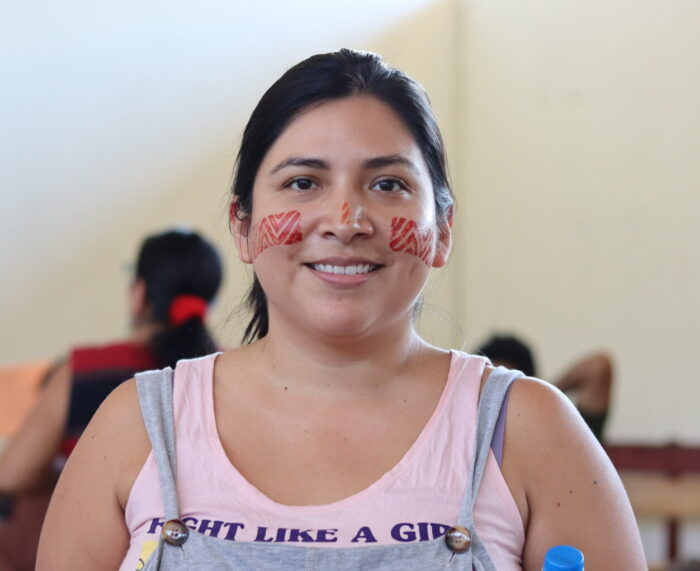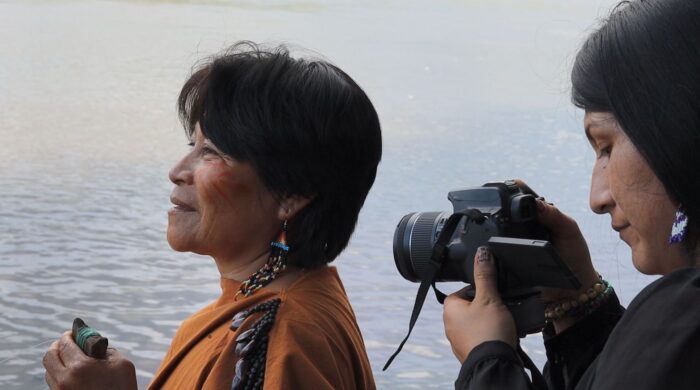Ingrid Arotoma - Co-production Research Toolkit Case Study

Peru-based PhD student Ingrid Arotoma used a co-production approach to overcome language and technology barriers, telling the stories of the Indigenous people of the Peruvian Amazonia in a way that truly made them participants in their own narrative.
Forming a relationship with University of Leeds
After graduating from university in Peru, Ingrid began working for private companies and then the Peruvian government, before realising she wanted to progress her studies further. ‘I felt uncomfortable in these roles, like I was sitting at the wrong side of the table,’ Ingrid explains. ‘I saw an advert asking PhD students to apply for a scholarship with University of Leeds within the School of Earth and Environment, and I immediately identified myself as right for the placement.’
A research document should not be the only end to the process and it certainly wouldn’t be a fitting outcome for these groups
Ingrid struggled in her earlier life to find a source of identity, but has become to know the Amazon as her home. ‘It’s why I wanted my scholarship to take me to the Peruvian Amazonia region,’ she explains.

Defining the meaning of participatory practice with vulnerable groups
Before beginning her research, Ingrid’s primary concern was to define what participatory methods truly meant for a vulnerable population. ‘It’s important to remember we’re talking about people who have become used to having research done about them and not with them,’ Ingrid stresses. ‘We need to question the reason for our research, how we’re going to approach it, and be clear about what we’ll do with the knowledge we gather.’
This understanding of the purpose of her research led Ingrid towards a co-production approach. ‘The Indigenous people of the Peruvian Amazonia are often asked about topics it’s difficult for them to talk about,’ she says. ‘I wanted to understand what was there for them in return for participation. A research document should not be the only end to the process and it certainly wouldn’t be a fitting outcome for these groups.’
Presenting co-production with the use of video
Ingrid decided to pursue participatory video research with nine young girls from OMIAASEC: an Ashanika women’s organisation in her region. ‘They act as gatekeepers to the community so are very critical about research and against those who have simply observed them before: quite rightly, they firmly told me they’re not “guinea pigs”,’ she explains. ‘A participatory approach was vital to get them to trust and work with me so I shared how I wanted to produce short documentaries, which they’d film themselves. I bought cameras, taught them how to use them, then left the cameras with them to record their lives in their own way. This gave them their own autonomy and voice.’
‘There was a real sense of pride amongst the girls over the use of the cameras,’ Ingrid says. ‘They began showing their skills and stories, and have full control of their own online space. And it’s great to see that being passed through the generations. One seven-year-old child who came to an early workshop is now the best photographer in the group! I love how it’s brought communities and generations together.’

Facing challenges with timings and technology
The Covid pandemic naturally presented some barrier to Ingrid’s research. ‘I could only arrange to meet the participants when it was completely safe to protect their communities from Covid,’ she explains. ‘This changed the project timelines significantly, but I’m fortunate I was living close by with the freedom of time to finish my PhD.’
‘As a consequence, we ended up with a lot of footage!’ smiles Ingrid. ‘Ideally I’d have stepped in to review at earlier intervals, but the pandemic meant the Indigenous people had time to capture much more of their story at once: I had six months’ footage from nine different communities. And they didn’t have computer access, so editing the footage became quite the challenge. To overcome that, I put a storyline together that formed a specific narrative, featuring things they felt important to share. Then, I replayed this back to them for their feedback so they were as included as possible in the process.’
Emphasising the benefits of shared participation
It was crucial for Ingrid to strike the careful balance between giving the Ashanika girls freedom to use the cameras and gaining the specific insight her research required. ‘I had to direct them towards capturing the key information I needed,’ Ingrid explains. ‘But I allowed them to do this on their own terms. My focus is on food and how climate change impacts the way we source and eat produce, and so the OMIAASEC girls used the cameras to interview elders about foods of the past and what’s changed today. I hadn’t considered that approach, proving how co-production can really drive alternative research focus.’
‘I want to highlight the importance of a participatory approach to research, especially for those working with vulnerable populations,’ continues Ingrid. ‘These communities’ views about what they’re comfortable with are clear and we should work with that, not against it. I was learning from the Ashanika people as well as giving something back to them with resources, like the cameras, which enabled the OMIAASEC to raise their social media profile. I also delivered a climate change workshop.’
‘Learning together is integral to participatory research practices,’ she concludes. ‘People like the Indigenous people of the Amazon need our time and focus, not our charity. It’s acknowledging them as collaborators of research and not as subjects that makes the co-production approach so important.’
